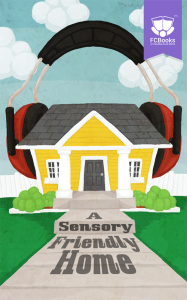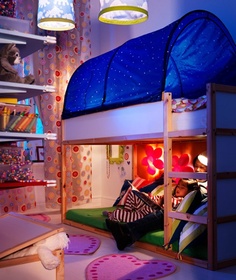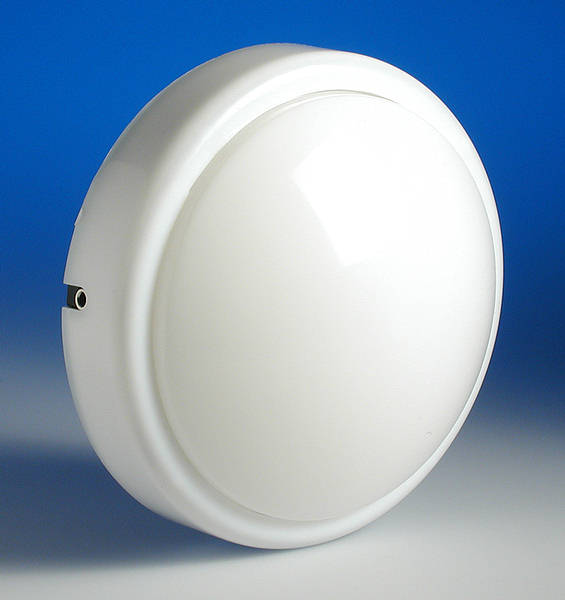
How to Create the Right Sensory Environment for a Good Night's Sleep
 If this post interests you, check out our newest E-book: A Sensory Friendly Home. This e-book is full of the ideas that were researched, experimented and dreamed of a sensory-friendly home – some are small changes and some are large projects. But everything has the same purpose: to make sure that a family grows together. That’s what makes a house a home.
If this post interests you, check out our newest E-book: A Sensory Friendly Home. This e-book is full of the ideas that were researched, experimented and dreamed of a sensory-friendly home – some are small changes and some are large projects. But everything has the same purpose: to make sure that a family grows together. That’s what makes a house a home.
15 Ways to Create a Sensory Friendly Bedroom
A sensory-friendly bedroom has only one purpose: to create an environment that maximizes the possibility for a long night of restful sleep.
Insomnia, night-waking and other sleep disturbances are frequent complaints of people with neurological differences, anxiety disorders, thyroid conditions, respiratory problems and digestive disorders. The good news is that modifying the sleep environment can help increase the length and quality of sleep in many cases.
My family has tried many different modifications over the years, and will probably try several more in the years to come, because we haven’t used up all of our tricks yet! Here is our working list for an ideal sensory bedroom, with elements from our past, present and future dreams of a good night’s sleep.
1. Color
 Medical research has consistently demonstrated that darkened rooms allow for deeper sleep than lighter rooms. When my family moved to a new home, one of the bedrooms was painted a rich burgundy color that looked black at night. The first night in that bedroom was the first time my younger son slept through the night, and his quality of sleep continued to improve in the weeks and months that followed.
Medical research has consistently demonstrated that darkened rooms allow for deeper sleep than lighter rooms. When my family moved to a new home, one of the bedrooms was painted a rich burgundy color that looked black at night. The first night in that bedroom was the first time my younger son slept through the night, and his quality of sleep continued to improve in the weeks and months that followed.
Choosing a dark color for bedroom walls does not necessarily mean choosing black or gray. Royal blue, emerald green, purple and crimson will all be very dark at night, especially if the ceiling is painted a dark color, too. But those colors will also be cheerful in the daylight.
2. Light
Once we had walls that absorbed light instead of reflecting it, we worked on blocking out other light sources. Less light means less night-waking. Here are some recommendations for minimizing light in the bedroom.- Blackout shades with dark-colored curtain on top to block the light that comes in around the edges of the shades.
 No night light, or turn off the night light after 1 hour
No night light, or turn off the night light after 1 hour- Turn the digital clock to face the wall
- No electronic devices in the bedroom after dark
- To move around during the night use a flashlight, switch on a night light or use a battery-powered “touch light” that mounts on the wall and uses a 3 watt bulb - do not use the overhead lights or a 60 watt lamp, because that will signal the human body to wake up!
- Light is also needed to help wake us up at the right time - a sunrise alarm clock mimics the sunrise by brightening gradually at a pre-set time for a gentle awakening.
3. Bed tent
A bed tent not only helps block out light and other stimuli, but it also provides a psychological cue that it is time to settle down and rest. A tent can create a sense of security and privacy that supports more restful sleep.
4. Pillows
My family uses pillows in several different ways. We used to place pillows on the floor at the end of the bed that has no guard rail, because our children are active, restless sleepers.
- Body pillows are a great choice for tummy sleepers, because they can be squeezed and shaped to support all the right places. Tummy sleeping or sleeping on the left side are recommended by gastroenterologists for people with acid reflux; sleeping on the right side usually worsens symptoms.
- For side sleepers, placing a pillow between the knees can help balance the hips and increase comfort during sleep.
- Personal Comfort Options: Soft, medium or firm pillows are a matter of personal comfort. Some people need to try several different types, and it can mean the difference between waking up refreshed or waking up repeatedly with a sore neck. Some people do not like the feeling of bumping a cold wall during the night, so a wall of pillows may be preferred.
5. Blankets
Blanket patterns and themes should be calming and positive, and may provide an image or idea to focus on while drifting off to sleep. My older son has always wanted to visit Paris, so when I was at the craft store and stumbled across a black and white fabric featuring sketches of Paris landmarks, I bought the whole bolt. I drew a pattern and asked my mother to make a duvet cover and pillowcases for my son. Paris is the last thing he sees every night before the lights go out, and he says that the images help him dream of La Ville-Lumiére.
Weighted Blankets Blankets of different weights and materials may be preferred at different times of the year. Weighted blankets are usually 1 to 15 pounds, and are popular among people with restless legs and insomnia. Occupational therapists recommend a blanket weight of 10% plus 1 pound of a person’s body weight, so for a person weighing 100 pounds, the blanket would be 11 pounds. Because the blanket provides gentle but deep pressure on the body, it stimulates the release of calming hormones and neurotransmitters all night long. Less expensive than weighted blankets, 100% cotton quilts start at around $55, with a twin size weighing in at 4.5 pounds.Some people like to create a cocoon of several blankets, some use a sleeping bag all year round, some have one favorite blanket that is always on the bed. The main disadvantage of using lots of blankets or a thermal sleeping bag is the risk of waking up from too much sweating. therefore, a seasonal rotation of blankets and sheets works best for cocooners.
For those who don't like blankets
But what if a person refuses blankets for sensory reasons - even in winter? I’ve got one of those in my family, too. He wakes up shivering and crying on cold nights. In this case, I learned to layer on pajamas - one layer of cotton footless pajamas in the summer, then a layer of fleece footed pajamas on top of that in the fall and spring. During the coldest months, he wears the cotton pajamas with two sets of fleece footed pajamas on top and socks on his hands as mittens.
People who don’t like most blankets may warm up to the Superblanky, a rectangular fleece superhero cape that is worn on the arms without restricting the neck. The Snuggie is another fleece blanket option with arm holes that is open in the back.
6. Noise
Noises from inside and outside the house are a major problem for sensitive individuals who are trying to sleep. Here are some tools to create a silent night:
- Foam or wax ear plugs
- White noise machine
- Soft music or natural sounds that repeat all night
- Air cleaner or other appliance that creates white noise
7. Safety
A bed rail is necessary for active sleepers who risk rolling out of bed. A rail does not stop the most active, but it does slow them down. Consider purchasing a portable bed rail that can be used at home and out of town.
If you’re going to be up and around in a dark home during the night, get rid of the things that always get tripped over or cause stubbed toes. After several nighttime injuries, we removed all of the wood and metal bed frames in our home. We became a “mattress on the floor” family. The bed rail became less necessary after the beds were lowered.
Place night lights in strategic locations around the home to prevent accidents: the hallway, bathroom and kitchen are prime spots.
8. Mattress type
Mattresses are a matter of personal preference, and they can make or break the ability to sleep. My husband and I noticed that our older son had difficulty staying asleep on bouncy, jiggly beds, so we ended up choosing for him a latex mattress that gives a sense of stability and reduces bounciness. Memory foam, futon and organic cotton mattresses also have minimal bounce. Of course, the least bouncy option is to sleep directly on the floor, which many people choose.
Try as many mattresses as possible in the store to see which is most comfortable. Be sure to ask about the coil type and coil count to get an idea of the amount of support the mattress provides.
9. Calming sensory activity for night-waking
Frequent night-wakers need a reliable method to get back to sleep. For many people, this may include getting a drink and using the bathroom. Some people need a little more calming sensory input. A hand-held massager, squeeze toy or fidget can work out that extra energy.
10. Textures and comfort items
Calming textures may also help a person get back to sleep after waking up in the night. Velour, satin and fake fur seem to be the the most popular textures. My children keep a few furry stuffed animals in their beds to squeeze and stroke as they fall back asleep. One of my brothers kept a piece of his baby blanket to stroke until he was well into adulthood.
11. Scent
Certain scents can have a calming effect on the nervous sytem and facilitate sleep. Lotion can be mixed with a few drops of lavender, ylang ylang or chamomile essential oils, or a satchet with these scents can be places near the bed.
12. Temperature
Sleep studies have consistently demonstrated that most people sleep best at a room temperature of 65 degrees. But this has never been true for my family. People with an unusually low percentage of body fat, like my husband and son, or those with circulatory issues may find themselves shivering under the covers all night at this temperature. We usually keep the house slightly warmer during the night than during the day. Experiment with opening and closing room vents to fit each person’s needs, and try different blanket weights and materials to maximize personal comfort.
13. Shelving
Another safety factor is stepping on objects during the night. Shelving and storage should be easily accessible, such as stacking bins or open shelves that keep toys visible. Knowing that everything is in its place can add to a sense of security and lead to more peaceful rest.
14. Decorating
Increased self-confidence means increased security. But there’s a fine line between overstimulating decor and decor that honors achievements and interests. So while a poster displaying types of trains may create a positive mood, setting up the entire train set in the bedroom may be more tempting than sleep. Consider how objects in the room fit into nighttime rituals and affect mood.
15. Alone or with a sleep buddy?
Some people sleep better with a pet or family member, while others need their own sleep space. Sharing a bed with a dog can help reduce anxiety, which in turn increases the quality of sleep.
One of my neighbors had all 4 of his children sleep in a king-sized bed together, and it was dramatic in helping to synchronize their sleep cycles. It all depends on temperament.
When dealing with a history of nonexistent or interrupted sleep, the only rule that matters is this: the right thing to do is whatever helps everyone get the best sleep possible.
Good night!



